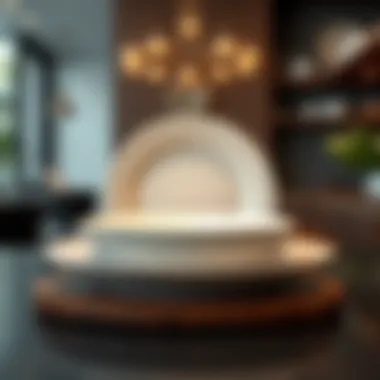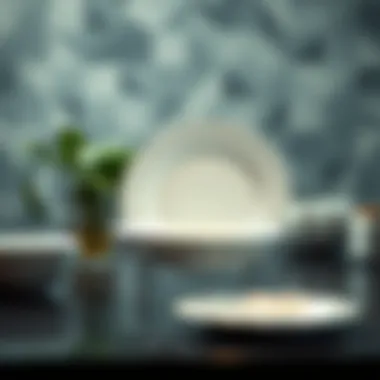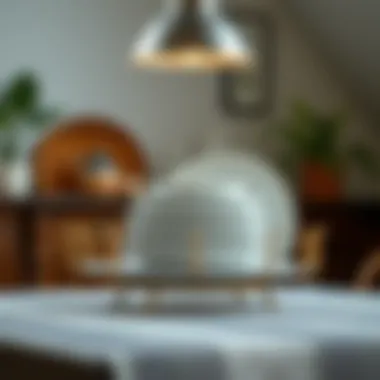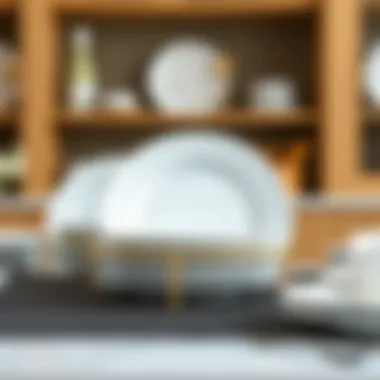Exploring Dish Plate Holders: Design and Trends


Intro
When it comes to home living, the details often make the difference between a functional space and a beautifully curated one. One such detail that sometimes gets overlooked is the dish plate holder. These kitchen staples not only serve a practical purpose but also enhance the overall aesthetic of your home. They can be a eye-catching addition to your dinnerware display while allowing you to keep your plates organized.
Dish plate holders have come a long way, evolving from purely utilitarian items to style statements that reflect modern designs and trends. As we dive into the world of plate holders, we'll break down their design, functionality, and the latest trends, providing insights that are valuable for homeowners, designers, and enthusiasts alike.
Furniture Styles and Trends
Plate holders come in an array of designs that mirror current trends and timeless aesthetics. Understanding these styles can aid you in making thoughtful choices that mesh well with your home decor.
Modern vs. Traditional: Understanding the Aesthetics
Traditional dish plate holders often incorporate ornate details and classic materials—think of wooden racks with intricate carvings. These tend to evoke a sense of nostalgia and warmth, making them perfect for rustic kitchens or dining rooms that seek a timeless appeal.
Conversely, modern plate holders embrace minimalism and functionality. You might find sleek metal holders or clear acrylic designs that serve a purpose without dominating the visual space. They are often characterized by clean lines and simplicity, lending an air of sophistication to contemporary kitchens.
"Style should never overshadow function. A good design balances both, enhancing your living space while serving its purpose effectively."
Color and Material Trends: What's In and What's Out
Choosing the right colors and materials for your dish plate holders can dramatically influence your kitchen's ambiance. Currently, earthy tones and natural materials such as bamboo or ceramic are quite popular. These materials not only have a rustic charm but are also often better for the environment.
On the other hand, bright colors and bold patterns are making a splash in modern kitchens, especially for those who favor eclectic designs. Textured metals or painted wood can bring a punch of personality, making the holder more than just practical.
Below are some trending materials:
- Bamboo: Eco-friendly and lightweight
- Ceramic: Adds a vintage touch and is easy to clean
- Metal: Durable and often used in sleek, modern designs
It’s best to avoid overly synthetic materials that might wear out quickly or are hard to recycle. Understanding both the visual impact and environmental considerations will help you make an informed decision.
Furniture Care and Maintenance
Regardless of style, proper care ensures that your dish plate holders remain functional and stylish for years to come.
Tips for Prolonging the Life of Your Furniture
- Regular Cleaning: Wipe your holders down with a damp cloth regularly to avoid dust buildup, especially in wood or woven designs.
- Avoid Excessive Moisture: Keep holders away from excessive humidity, which can warp materials like wood or lead to rust in metal.
- Use Coasters or Liners: If placing dishes directly on the holder, consider using soft liners to prevent scratches or stains.
DIY Repair Hacks for Common Furniture Issues
Furniture can take a beating over time. Knowing how to fix minor issues can save you time and money. Consider these quick solutions:
- For scratched wooden holders, use a wood touch-up marker or make a paste from olive oil and vinegar to restore the surface’s luster.
- For metal holders, a simple mixture of baking soda and water can work wonders for rust—apply, let sit, and scrub gently.
By taking these steps, your dish plate holders can maintain their beauty and function even as time marches on.
Closure
Dish plate holders are essential components of kitchen decor that marry style with utility. As trends in design and materials change, keeping up-to-date helps to ensure your home stays fresh and welcoming. Remember to prioritize both functionality and aesthetics when selecting your plate holders, allowing them to be both a practical and beautiful part of your kitchen ensemble.
For more information, check resources like Britannica's overview of home design or Wikipedia coverage on kitchen organization. Explore communities on Reddit for more DIY tips and trends.
The Importance of Dish Plate Holders in Modern Kitchens
In today's fast-paced world, the kitchen is often viewed as the heart of the home, making it essential for kitchen elements to serve both functional and aesthetic purposes. Dish plate holders play a pivotal role in achieving these goals. Their importance extends beyond mere storage; they help maintain order, add style, and ultimately enhance the kitchen experience.
Organizational Benefits
Dish plate holders bring a specific kind of organization that is hard to replicate. Imagine having a stack of plates piled haphazardly in a cabinet—it's not just cluttered; it can lead to chipped dishes and wasted time. This is where dish plate holders shine. They provide a designated spot for every plate, preventing chaos and extending the lifespan of your dishware.
A well-organized kitchen can significantly reduce stress. When your plates are easy to access and neatly stored, you can whip up meals without rummaging through cabinets. Additionally, special dish holders like wall-mounted racks or countertop stands can free up space, meaning you get more room for other kitchen essentials. For those with smaller kitchens, maximizing storage without sacrificing style is a must.
"An organized kitchen is a happy kitchen."
This statement rings true for many home chefs. Knowing where everything is adds a layer of peace. Most plate holders are designed with both efficiency and aesthetics in mind. They reduce the time spent searching for items, allowing for better planning in meal preparation and entertaining.
Aesthetic Contributions


The visual appeal of a kitchen often relies on how well its elements complement each other, and dish plate holders significantly contribute to this. Whether they are sleek metal designs or rustic wooden constructions, these holders can function as more than just practical installations—they can enhance the aesthetic charm of your space.
Colors, materials, and styles play a crucial role. Integrating a dish plate holder that matches your kitchen's decor adds a touch of seamless elegance. For instance, a farmhouse-style wooden holder can evoke a sense of nostalgia and warmth in a contemporary setting. Conversely, minimalist metal designs can impart a modern edge that speaks to chic sensibilities.
Consider also the variety of finishes available. A shiny chrome holder might be ideal for a modern kitchen, whereas a matte black finish could work well in a more industrial space. This synergy of function and style allows homeowners to express their personal taste, thereby adding character to one of the most important rooms in their home.
Historical Context of Dish Plate Holders
Understanding the historical context of dish plate holders provides crucial insight into how these practical kitchen tools have developed over time and why they hold significance in today’s design landscape. Dish plate holders are not just mere organizational tools; they encapsulate cultural shifts, changes in material technology, and evolving design philosophies that mirror our lifestyles. As we peel back the layers of their past, it becomes apparent that these holders tell a story of functionality harmonizing with aesthetics—an interplay that remains relevant for homeowners, designers, and culinary enthusiasts alike.
Early Designs and Materials
In ancient civilizations, the concept of organizing kitchenware can be traced back to the use of simple wooden racks or stone platforms. For instance, in many Mediterranean societies, basic shelves made from local timber were utilized to hold plates and bowls, often decorated with intricate carvings that reflected local artistry.
As ceramic technology developed around the time of the Ming dynasty in China, plates became more desirable and, subsequently, required better storage solutions. During this time, we see the first instances of specialized plate holders emerging, typically fashioned from bamboo or lacquered wood, creating a blend of form and function.
In Europe, the arrival of the Renaissance saw an explosion of creativity in plate design. Dish plate holders began to evolve from mere functional items to decorative pieces that accentuated the grandeur of dining spaces. Materials like wrought iron and ornate brass became popular during this era, often used in the making of holders that featured elaborate designs.
Many early designs emphasized a hierarchical organization, where more precious china was displayed prominently, symbolizing wealth and status. Subsequently, the evolution of glass and porcelain in the 18th century also influenced plate holder designs, leading to lighter and more delicate frameworks to support an expanding array of dishes.
Evolution Through Time
Fast forwarding to the 19th century, the industrial revolution brought significant changes to kitchenware, including dish plate holders. Mass production allowed for new materials and innovations, making these holders accessible to the average household. Functionality, not just ornamentation, took center stage. Plate holders became more about saving space and allowing for easy access rather than just display.
By the early 20th century, with the increasing popularity of compact kitchens and modern home design, manufacturers began creating streamlined versions of plate holders. This was a pivotal era, as practicality was paramount, leading to the creation of stackable designs and modular systems that could adapt to various kitchen layouts. Materials transitioned to durable metals and plastics, which provided increased longevity and ease of cleaning.
In recent years, the emphasis on sustainability has also shaped the market for dish plate holders. Designers are now revisiting ancient techniques while integrating renewable materials that harmonize with contemporary tastes. As homeowners become more eco-conscious, holders crafted from bamboo, reclaimed woods, and even recycled metals are enjoying a resurgence. This confluence of history and modernity is shaping a fresh narrative for dish plate holders.
Ultimately, understanding the historical journey of dish plate holders benefits homeowners and designers alike, as it contextualizes the current trends and considerations that align functionality with aesthetic appeal. The rich tapestry of their evolution offers valuable insights into how to select and style these essential kitchen components.
Types of Dish Plate Holders
When it comes to organizing your kitchen, the type of dish plate holder you choose can make a significant difference. Various designs cater to unique needs and preferences, ensuring that both functionality and aesthetics walk hand in hand. Embracing the right dish plate holder can elevate your kitchen's organization and sharpen its style. Let's take a closer look at the various types available, each with its own array of benefits and considerations.
Wall-Mounted Holders
Wall-mounted holders are a fantastic option for maximizing space. By going vertical, you free up countertop areas that can harbor other essential tools or decorative pieces in your kitchen. They tend to give the kitchen an open feel, as well as lend a rustic or modern touch, depending on the design you choose.
For instance, a wooden plate rack can create a homey vibe while showcasing your favorite dishware. On the flip side, a sleek, metal version might offer a more contemporary flair.
"A well-chosen wall-mounted plate holder not only organizes but can become a conversation piece, displaying your best dishes like art."
Moreover, wall-mounted holders can work in nearly any kitchen layout, making them quite versatile. To ensure they align with your kitchen design, consider factors like the width and depth of your plates. You wouldn’t want your prized porcelain plate squished! Occasionally checking and cleaning the area is also essential to keep dust at bay.
Countertop Stands
Countertop stands provide an easy-access solution for everyday dishes. Whether you have a bustling family or simply enjoy hosting gatherings, keeping plates handy is crucial. Many countertop designs feature tiered racks, which allow multiple stacks of dishes without taking up too much vertical or horizontal space.
Materials often range from steel to bamboo, each offering distinct benefits. For example, bamboo is lightweight and resistant to moisture, making it a suitable option for kitchens of all kinds. However, if durability is your concern, opting for stainless steel might be the way to go. Its sleek, shiny finish can also complement modern kitchen decor beautifully.
When selecting a countertop stand, take note of your dishes’ sizes. Some stands may not accommodate larger or deeper plates. You also need to consider your kitchen's traffic flow; a perched stand can easily become a hurdle if not positioned wisely.
Drawer Storage Solutions
Drawer storage solutions are perfect for those who prefer a hidden organization method. This design provides discreet storage while keeping plates safe and protected from dust and chips. Utilizing pull-out racks or nested trays can reduce scrapes and scratches, preserving your dishware for years. It’s a perfect blend of practicality and aesthetics.
To get the most from drawer storage, consider the following:
- Sizing: Ensure your plates fit comfortably without cramming them together. You want the drawer to reflectOrderliness.
- Accessibility: Ensure all dishes are easy to grab, even if they’re tucked away.
- Material: Opt for sturdy trays—modular systems in materials like laminate are easy to clean and fit excellently.
In sum, the right type of dish plate holder makes a tangible difference in how you organize and display your plate collection. It's all about understanding your kitchen needs and making a thoughtful choice that complements your lifestyle.
Materials Used in Dish Plate Holders
Understanding the materials used in dish plate holders is crucial for both functionality and aesthetics in kitchen design. Choosing the right materials can elevate a simple dish plate holder into a centerpiece that complements your kitchen's style while providing the practical support necessary for organizing plates. Each material brings its own unique characteristics, advantages, and considerations that can significantly impact the overall user experience.
Wooden Holders


Wooden dish plate holders are often the choice for those looking to evoke a sense of warmth and natural beauty in their kitchens. They come in various types of wood, like oak, bamboo, and walnut, each adding its own character. For example, bamboo is not only eco-friendly but also remarkably strong, making it a popular choice among environmentally conscious homeowners. Wooden holders can also be designed with intricate carvings or smooth finishes that speak to a craftsman’s touch.
Advantages of Wooden Holders
- Aesthetic Appeal: Wood offers a timeless look that can frame plates beautifully, making them look like pieces of art.
- Durability: When treated properly, wooden holders can last for many years, resisting warping or cracking.
- Natural Insulation: Wood naturally insulates, safeguarding your plates from temperature changes.
However, wooden holders do require maintenance—oil treatments can keep them from drying out or discoloring. It’s essential to avoid soaking wooden holders in water as they can warp over time.
Metallic Options
When one thinks of metallic dish plate holders, a sleek and modern look often comes to mind. Materials like stainless steel and wrought iron are prominent in this category, appealing to those who favor contemporary kitchen aesthetics. Stainless steel, in particular, is sought after for its resilience against rust and corrosion, making it an ideal option for high-moisture environments.
Benefits of Metallic Holders
- Longevity: Metals like stainless steel are incredibly durable and can withstand daily wear and tear.
- Easy to Clean: Most metal holders can be wiped clean quickly, making them low-maintenance.
- Versatile Design: They can take various shapes and styles, from minimalist lines to ornate designs.
On the downside, metallic holders can be heavy, which may not suit every home, especially if wall-mounted. It’s also worth considering that some metals can be cold to the touch, which might affect its usability.
Plastic and Eco-Friendly Alternatives
Plastic holders have undergone a transformation in recent years, with designs becoming more innovative and stylish. They can replicate the look of wood or metal while offering lighter and often more affordable options. Eco-friendly plastics, often made from recycled materials, are now emerging as a sustainable alternative. This shift aligns with today's trend towards a greener lifestyle.
Pros of Plastic Holders
- Lightweight: Easy to move and rearrange, these holders can suit various kitchen layouts.
- Cost-Effective: Generally, plastic holders are more affordable than their wooden or metallic counterparts.
- Variety of Colors and Designs: They come in numerous colors and styles, making them a versatile option for those looking to add a pop of color.
Nevertheless, not all plastics are created equal; some may not be sturdy enough, leading to potential issues with durability. Plus, while many are dishwasher safe, they can wear out or fade over time if frequently exposed to harsh conditions.
Choosing the right materials for dish plate holders hinges on balancing practicality with style. Each option—wood, metal, or plastic—offers its set of advantages and disadvantages, challenging users to consider their own needs, aesthetics, and values. In any case, the right dish plate holder ultimately enhances both the functionality and the elegance of a kitchen space.
Design Considerations
When it comes to dish plate holders, design considerations play a significant role in enhancing both the aesthetic appeal and functionality of your kitchen. With a wide variety of styles, materials, and sizes available, homeowners have an opportunity to choose a plate holder that not only serves a practical purpose but also complements their kitchen’s ambiance. This section highlights the essential aspects to think about while selecting the perfect dish plate holder.
Style Matching with Kitchen Decor
First off, the style of your dish plate holder should resonate with the overall decor of your kitchen. Whether your space leans more towards rustic charm, modern minimalist, or classic elegance, aligning your plate holder's design with your kitchen aesthetic is key.
- Color Palette: Consider the colors present in your kitchen. A dish plate holder in a complementary shade can enhance the room's visual harmony. For instance, a soft gray wooden holder might be ideal in a kitchen with white and pastel highlights.
- Material Harmony: If your kitchen features stainless steel appliances, a metallic dish plate holder will not only match but also elevate the sleek look. Alternatively, a plate holder crafted from reclaimed wood can add warmth to an otherwise sterile environment.
- Design Elements: Look at patterns, shapes, and sizes. A delicately designed holder can serve as a statement piece in a minimalist kitchen, while a more robust design could fit well in a farmhouse aesthetic.
Style doesn’t just reflect the beauty of your kitchen; it significantly enhances the overall experience as you cook and dine. A well-coordinated space tends to be more inviting and comfortable.
Functional Design Elements
While aesthetics are crucial, the functionality of dish plate holders should not be overlooked. These holders must not only look good but also perform well, ensuring safe storage and easy access to your plates.
- Stability and Support: It’s crucial to select a design that provides adequate support to prevent plates from tipping or falling. A robust base can offer peace of mind when storing your precious dinnerware.
- Space Efficiency: Consider the size and form of the plate holder. Foldable, wall-mounted, or stackable options can save space in smaller kitchens, while larger countertop models can display your dinnerware elegantly if you have the room to spare.
- Accessibility: Ensure that your choice allows for easy access to your plates, especially during busy meal prep times. Look for holders that offer a clear view and a straightforward reach.
- Versatile Usage: Some plate holders come with features that allow for multipurpose use, such as drying or organizing pots and pans alongside plates. This versatility can help streamline kitchen tasks.
In sum, selecting a dish plate holder isn't merely about choosing something that looks good. It is also about functionality and adaptability to your cooking and serving needs. Paying close attention to both the design aspects and practical features will enhance your overall kitchen experience.
Selecting the Right Dish Plate Holder
Choosing the right dish plate holder isn't just about picking the first one that catches your eye at the store. It's a crucial step in upgrading your kitchen's efficiency and aesthetic. A well-selected plate holder can enhance organization, complement your decor, and even save you from unnecessary stress when it comes to finding what you need at mealtime. Here, we delve into what to consider before making a decision, ensuring that your choice meets both practical and style expectations.
Determining Your Needs
When it comes to dish plate holders, one size doesn’t fit all. Before you hit the stores or start scrolling through online retailers, take a moment to think about how you use your kitchen. Assess your dishware collection. Do you have a mix of large dinner plates and smaller dessert plates? Or perhaps you’ve got a set of fine china that deserves a designated display? Knowing what you need will guide you to the most suitable solution.
- Frequency of Use: If you regularly entertain guests or cook elaborate meals, a holder that provides easy access is essential. A well-planned holder can give you not only a place to keep your dishes but also to showcase them, especially if they’re particularly beautiful or have sentimental value.
- Type of Dishes: Consider the range of plates you own. If your collection includes oversized platters or uniquely shaped dishes, then an adjustable or custom size holder may be the best route for you.
- Personal Style: Think about what fits in with your kitchen atmosphere. If you love rustic charm, a wooden dish holder might appeal. Alternatively, a sleek metal holder might suit a more contemporary or minimalist kitchen.
Considerations for Space and Capacity
Space can be the elephant in the room when selecting a plate holder. A dish holder needs to fit within your kitchen’s layout and still provide you room to move around comfortably. Here are a few considerations:
- Available Space: Look at your countertop space, cabinets, and even the wall areas. Wall-mounted holders can save counter space while providing a stylish storage solution. For those who prefer countertop stands, think carefully about where you'll place them to avoid clutter.
- Capacity Needs: Depending on how many plates you own or plan to acquire, the capacity of the holder is essential. If you frequently host dinner parties, consider a holder that can store a larger quantity. In contrast, if you're looking to downsize or simplify, a smaller holder might be more effective.
- Adjustability: Look for options that offer some level of adjustability. Modular systems or expandable racks can grow with you over time, accommodating your ever-evolving collection of dishware.


As you contemplate your options, remember that selecting the right dish plate holder isn't merely a mundane task. It's about enhancing your kitchen experience, making each meal preparation just a tad easier and much more enjoyable. Whether it’s the functionality or the flair that you prioritize, understanding your needs and space are foundational steps in this buying journey. The right holder can transform a utilitarian task into a satisfying display.
Trends in Dish Plate Holders
In the ever-evolving landscape of kitchen design, dish plate holders have transformed from mere organizational tools into stylish statements. Understanding the latest trends is crucial for anyone looking to curate a modern and functional kitchen environment. Homeowners and designers alike need to consider not just how these holders function, but also how they contribute to the overall aesthetic of a space. Let’s delve into the key trends shaping the future of these kitchen essentials.
Emphasis on Sustainability
Sustainability isn't just a buzzword; it has evolved into a fundamental principle that resonates in many aspects of contemporary design, including dish plate holders. Consumers are increasingly seeking products that are not only functional but also environmentally responsible. This shift has prompted manufacturers to lean towards materials that are either biodegradable or sourced sustainably.
Here are some insights about this trend:
- Made from Recycled Materials: Items such as bamboo, reclaimed wood, and recycled plastics are gaining traction. These materials not only reduce waste but also offer a natural aesthetic that blends well with various kitchen designs.
- Durability and Longevity: Sustainable doesn’t mean flimsy. Many modern holders are designed to last, reducing the need for replacements. This approach supports the idea of investing in quality over quantity, which resonates well with eco-conscious consumers.
- Zero-Waste Design: Some innovative designs aim to reduce packaging waste by incorporating multiple functionalities into one holder, cutting down on the overall need for multiple items.
This movement towards sustainability underscores a growing awareness that extends beyond aesthetics; it reflects a thoughtful consideration of one’s impact on the environment.
Minimalist and Contemporary Designs
As homes are becoming more streamlined, the trend towards minimalist and contemporary design is also making waves in the realm of dish plate holders. Clutter is being swapped for clean lines and understated elegance, offering an appealing simplicity that enhances the visual flow of the kitchen.
Here are key points related to minimalist designs:
- Streamlined Shapes: A focus on geometric designs allows dish plate holders to meld seamlessly into the kitchen space rather than overpowering it. Simple, yet striking holders convey a sense of balance and modernity.
- Neutral Color Palettes: Trending colors are often muted—think whites, grays, and natural wood tones—allowing the dish plate holder to act as a canvas rather than a distraction. This palette aligns well with the minimalist philosophy.
- Functional Aesthetics: In contemporary design, functionality is key. Holders are now built to accommodate various plate sizes while ensuring ease of access, making them not only visually pleasing but also practical.
In this context, dish plate holders serve more than just a storage function; they become integral to the overall design language of a space, channeling a sense of order and tranquility into the kitchen environment.
Installation and Maintenance
The effectiveness of dish plate holders can be greatly influenced by how they are installed and maintained. Proper installation not only ensures safety and stability but also enhances the overall functionality and aesthetic appeal of the holder. Maintenance, on the other hand, keeps the dish plate holder looking pristine and prolongs its lifespan. Understanding these aspects is crucial for homeowners, designers, and DIY enthusiasts alike, as it can turn a simple kitchen accessory into a lasting addition.
Proper Installation Techniques
When it comes to installing dish plate holders, attention to detail can make all the difference. Here are several key techniques to consider:
- Choose the Right Location: Consider where the holder will be placed. It should be easily accessible, yet not obstructive to other kitchen activities. Positioning it near the dish rack or in a corner can optimize functionality while keeping it out of the way.
- Use Leveling Tools: An uneven holder can cause plates to slide or fall off. Utilizing a level ensures that the installation is straight, giving you peace of mind about the holder's stability.
- Anchor Appropriately: If the holder is wall-mounted, use appropriate anchors based on the wall material—whether drywall, plaster, or masonry. This prevents any accidents that may occur from inadequate support.
- Follow Manufacturer Guidelines: Every product comes with specific installation instructions. Adhering to these recommendations helps to secure the holder correctly and maximizes its durability.
- Landscaping the Edges: If there are sharp edges, consider sanding them down. This not only provides a smooth finish but also reduces the risk of cuts when handling plates.
Carefully considering these factors during installation can set the stage for effective use.
Cleaning and Care Recommendations
Like any kitchen item, dish plate holders require a bit of TLC to maintain their functionality and appearance. Here are some suggestions for keeping your holder in top shape:
- Regular Dusting: Dust tends to settle on surfaces, even in the kitchen. A quick wipe down with a soft, damp cloth can help eliminate dust and prevent scratches on the finish.
- Use the Right Cleaners: Be mindful of the materials used in your dish plate holder. Wooden holders benefit from natural oils like lemon oil to keep them looking fresh, while metallic options may need a gentle metal cleaner to avoid tarnishing.
- Avoid Water Damage: For wooden holders, excessive water can warp the material. It’s best to minimize exposure to moisture and dry any spills immediately to maintain the integrity of the wood.
- Inspect for Wear and Tear: Regularly inspect the holder for loose screws, cracks, or any signs of wear. Addressing small issues promptly can prevent larger problems from developing over time.
"A stitch in time saves nine" — Regular maintenance can save you the hassle of replacing your holder down the road.
- Resilience Check: If you have a plastic holder, check for brittleness over time especially in changing temperatures. If it doesn’t feel as sturdy as before, it might be time to replace it.
Following these guidelines ensures that your dish plate holder remains a stylish and functional part of your kitchen for many years. By taking the time to install carefully and maintain regularly, you can elevate your kitchen space while ensuring practicality remains intact.
The Future of Dish Plate Holders
In the coming years, dish plate holders are poised to undergo significant transformations that reflect broader technological and design trends. With the evolving landscape of kitchen design, these holders are not merely shelf fixtures; they represent a shift towards functionality infused with innovation. Understanding what lies ahead can help homeowners, designers, and enthusiasts make informed decisions about their kitchen organization solutions. The future holds promise for both smarter designs and environmentally-friendly options, creating an exciting convergence of style and utility.
Integration with Smart Home Technology
As homes embrace smart technology, the integration of dish plate holders into these systems is increasingly relevant. Imagine a dish plate holder that not only keeps your dinnerware organized but also connects to your home assistant. This future might one day allow you to command your smart device to locate specific plates or even notify you when it's time to wash your dishes based on usage patterns.
Several benefits emerge from this integration:
- Convenience: With smart features, plates can be reminded of regular cleaning schedules or stored usage data.
- Organization: Devices may offer real-time feedback on inventory levels, alerting homeowners when it’s time to restock or replace certain pieces.
- Customization: Smart systems can adapt to individual preferences, adjusting settings based on user habits.
The key to a successful integration will be ensuring simplicity. If it’s more trouble than it's worth, users may shy away from using it. Balancing tech and practical usability will be vital in this evolutionary phase of dish plate holders.
Emerging Trends to Watch
Several trends are on the horizon for dish plate holders that coincide with evolving consumer preferences and socio-environmental responsibilities. Keeping an eye on these can provide innovative ideas for future kitchen aesthetics and functionality:
- Sustainable Materials: Increased demand for eco-friendly products means a rise in bamboo, recycled metals, or biodegradable options. Consumers are more likely to resonate with brands that prioritize the environment.
- Modular Designs: These allow customization based on space and personal style. Users may choose to mix and match holders to fit their kitchen's layout, creating an organized yet personalized environment.
- Health Considerations: As awareness of hygiene rises, innovative materials that resist bacteria or are easy to clean will become key in design considerations. This trend will integrate seamlessly with the growing focus on wellness in home environments.
"Homeowners today desire not just organization but a harmonious blend of design, utility, and sustainability in their kitchen solutions."
- Aesthetic Versatility: Dish plate holders are not just for keeping items organized; they will increasingly serve as statement pieces that enhance kitchen decor, leveraging unique designs and colors that appeal to modern aesthetics.















